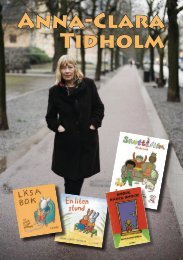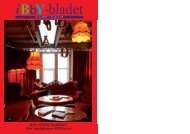PETER PAN-PRISET till Ho Baek Lee och Ensam ... - IBBY Sverige
PETER PAN-PRISET till Ho Baek Lee och Ensam ... - IBBY Sverige
PETER PAN-PRISET till Ho Baek Lee och Ensam ... - IBBY Sverige
Create successful ePaper yourself
Turn your PDF publications into a flip-book with our unique Google optimized e-Paper software.
expressing themselves. I am now able to manage to do<br />
both, on one hand please the publishers, teachers, and<br />
parents, and on the other hand reach the children.<br />
8<br />
You have worked with many different illustrators.<br />
<strong>Ho</strong>w would you describe a successful collaboration<br />
between text and image, between writer and illustrator?<br />
And what are your personal thoughts on the<br />
fusion between the text and the pictures?<br />
I think writers and illustrators should be put in contact<br />
at a very early stage in the making of a book. The<br />
purpose of that is not for the writer to suggest ideas to<br />
the illustrator, but rather for the illustrator to know<br />
the writer as a person so he/she understands where the<br />
story comes from.<br />
The writer says everything he/she wants to say in<br />
the text, and has no right to have requests for the<br />
illustrator. The job of the illustrator is to add his/her<br />
imagination to the imagination of the writer. I believe<br />
that the illustrations should be complementary to the<br />
text rather than interpretative of the story.<br />
The images should not limit the imagination of the<br />
child, and they should be of high artistic quality. By<br />
presenting such high quality books to children we show<br />
them respect, and we guide them to respect the book.<br />
You also work with many different publishing houses<br />
– both in the Arabic world and in Europe. Can<br />
you tell us a little about your contact with your<br />
publishers and advantages and disadvantages with<br />
having publishers in different parts of the world.<br />
Can you, for example, maintain the creative influence<br />
over the choice of illustrators?<br />
I think I am very privileged to be able to publish with<br />
several publishing houses. I am a full time writer, and<br />
therefore I produce a lot of books for the various age<br />
groups.<br />
When I write a new book, I decide where to send it<br />
based on my knowledge of theses publishers and their<br />
different interests. So the advantage is in this large<br />
spectrum of choices. The disadvantage is that sometimes<br />
I feel one specific publisher is upset about me<br />
choosing to give a book to someone else.<br />
A writer can’t escape the feeling of being in the<br />
middle of the battle fields between some publishers,<br />
especially when these happen to be in a small country<br />
like Lebanon.<br />
As to the choice of illustrators, usually it is the<br />
publisher that decides which illustrator to assign to a<br />
given book. As a writer, I am asked if I like the style of<br />
the primary samples of the illustrator. But when it comes<br />
to the final details, sometimes the publisher’s decision is<br />
the final decision, even though I express some remarks<br />
for a change (this not true in all cases though).<br />
What are your views on children’s books, and<br />
children’s culture in general, now after the Arabic<br />
revolutions? Do you think children’s literature can<br />
have an effect on the development of the society?<br />
I think this is an opportunity for the Arab world to<br />
realize that the future will be brighter if we invest in<br />
the new generations culturally, educationally, and socially.<br />
Here comes the role of books which will be the<br />
children’s first window to the outside world.<br />
But before we show our children that reading and<br />
love of books is the eye opener to the world, the adults<br />
themselves should start loving the book. As you know,<br />
there is a stereotype about Arabs that they don’t read.<br />
This is truly a stereotype and a generalization, but it is<br />
also based on some experience. Future societies will be<br />
built by our children. We need to equip them with a<br />
strong base. The love of books and reading is only the<br />
beginning of this investment.<br />
Your own future plans – what will you be doing<br />
next? Will you write more books for teenagers?<br />
Will you continue to write picture books? Do you<br />
have other projects in mind? Will you write for<br />
adults too?<br />
When I first started writing, about ten years ago, there<br />
were very few other writers who were specialized in<br />
children’s literature. I humbly say I played a pioneering<br />
role in this field in my country and the Arab region in<br />
general. Now, the status of Arabic children’s literature<br />
has advanced a lot. More publishers, writers, and illustrators<br />
are fully dedicated to this field now.<br />
The big gap we s<strong>till</strong> have is in Young adult books. I<br />
published my first book, Fatin, recently, and I am about<br />
to finish my second one. I think in the future I would<br />
like to focus on this age group, since teenagers have<br />
never been treated, in my culture, as a distinct category<br />
of readers.<br />
They are one day children, and as they hit puberty,<br />
they become adults. I do not plan to write for adults.<br />
Regarding other projects, sometimes I dream of<br />
establishing an Art and Culture Children’s Center. I do<br />
not know if this will happen one day.<br />
Internationella biblioteket i Stockholm har flera böcker av<br />
Fatima Sharafeddine.<br />
Crying Lion<br />
Plötsligt fanns de bara där i min dator. Nya bilder av<br />
John Kilaka från Tanzania. Kilaka som berikat så<br />
många barn (<strong>och</strong> vuxna) med sina lovsånger <strong>till</strong> vänskap<br />
<strong>och</strong> försoning i bilderböcker som Färsk fisk, Vilken<br />
vän <strong>och</strong> Förtrollad frukt. Alla som färgstarka fabler i<br />
Tingatinga-traditionen.<br />
Och som gjorde sån succé på bokmässan i Göteborg<br />
2010<br />
Nu är en fjärde bilderbok på gång. Den har titeln<br />
Crying Lion <strong>och</strong> handlar enligt författaren/konstnären<br />
om ett lejon som när han blev kung körde hårt med<br />
sina undersåtar <strong>och</strong> krävde att de skulle komma med<br />
gratis mat <strong>till</strong> honom hela tiden. De andra djuren försökte<br />
på olika listiga sätt jaga bort honom men misslyckades.<br />
Till slut var det i vanlig ordning ett litet oansenligt<br />
djur (en myra) som löste upp knutarna.<br />
Boken är nästan klar <strong>och</strong> kommer att publiceras på<br />
John Kilaka visar bilder ur sin nya bilderbok Crying Lion<br />
för en skolklass i Tanzania. Okänd fotograf.<br />
swahili, tyska, engelska <strong>och</strong> förhoppningsvis även på<br />
danska <strong>och</strong> svenska. Eller hur Hjulet?<br />
Det ryktas på stan att John Kilaka kommer <strong>till</strong><br />
<strong>Sverige</strong> senare i år. Det ser vi fram emot.<br />
SH




